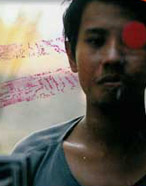 |
||
|---|---|---|
| CP Foundation | About CP Biennale | 2003 | 2005 | Contact Us | >||
           
|
||
|
Wimo tends to take black-and-white pictures, although sometimes there are full colors objects in his works, such as in the depiction of the book cover he reads on the toilet. Wimo generally takes an alternative route in taking photographs. Unlike the stream of "salon photography" that pays through attentions to smooth and clean artistic qualities, Wimo likes to use objects that others would dismiss or ignore due to their lack of aesthetic or artistic quality. Wimo's camera operates in territories most would consider as outside the ideal realm for photography. For Wimo, his own body can serve as his conceptual and aesthetic model. He makes notes on his body, creating himself as the ego. He portrays himself in a closed restroom, with female breasts on his back. "There is a woman inside me," he says. The statement obviously has no literal meaning but signifies something deeply personal. Another of his works has the picture of the influential photography book, The Photobook, with its cover portrayed upside-down. There Wimo is depicted sitting simply and seriously reading. Wimo had his friend taken the picture according to his instructions. Wimo's works reveal himself in a cage he builds for himself. There is certainly an aesthetic choice and reason behind it, as he breaks down the photographic conventions of smooth, cheerful, and artistic pictures. His pictures do not merely say a thousand words, but also reflect the paradoxes that exist within him. With the pictures, he humors himself. This obviously is the reflection of an agent of our contemporary social system and culture. Wimo's paradoxical and satirical works betray our own cultural and social face. To us, Wimo's pictures report on our dreams, imaginations, and cynicism. It reveals, for example, Wimo's cynical stand on the unending reproductions of art. Wimo's works represent the photography that does not always succumb to the aesthetics of excellence. They offer glimpses on his personal life that appears with many intriguing attributes. A. Sudjud Dartanto Born on October 14, 1976 in Magelang. SELECTED GROUP EXHIBITIONS |
||
|
CP Foundation | About CP Biennale | 2003 | 2005 | Contact Us
Jl. Suryopranoto 67A, Jakarta 10160, Indonesia. ph. +62.21.3448126, 3853206 | fax. +62.21.3853203, 3853208 info@cp-foundation.org |
||
 To take a photograph is to record the light. For hundreds of years, camera has introduced the 'realism in representations'. In its early years, vigorous debates took place between the photography and the painting sides, as painting, at that time, had been the trusted medium to reflect reality. The emergence of photography then triggered the birth of many streams in the practice of modern painting. Today, chemical-based photography faces its own challenge with the emergence of digital cameras. Digital cameras record the reality directly, and enable the images to be processed or manipulated on computers. Photography at the end is essentially similar to other practices in visual arts: it visually represents the opinions and aesthetic ideas of the artist. We read thus Wimo Ambala Bayang's works as we keep in mind the state of photography today, when visual technology offers enchanting possibilities. The camera offers a subjective world as it expresses the artist's aesthetic ideas. This fact is obvious in Wimo's works, they present the reality complete with all its aesthetic concepts and attachments.
To take a photograph is to record the light. For hundreds of years, camera has introduced the 'realism in representations'. In its early years, vigorous debates took place between the photography and the painting sides, as painting, at that time, had been the trusted medium to reflect reality. The emergence of photography then triggered the birth of many streams in the practice of modern painting. Today, chemical-based photography faces its own challenge with the emergence of digital cameras. Digital cameras record the reality directly, and enable the images to be processed or manipulated on computers. Photography at the end is essentially similar to other practices in visual arts: it visually represents the opinions and aesthetic ideas of the artist. We read thus Wimo Ambala Bayang's works as we keep in mind the state of photography today, when visual technology offers enchanting possibilities. The camera offers a subjective world as it expresses the artist's aesthetic ideas. This fact is obvious in Wimo's works, they present the reality complete with all its aesthetic concepts and attachments.